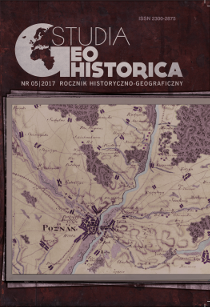Średniowieczne i wczesnonowożytne młyny ziemi liwskiej (Młyny na Czerwonce)
Medieval and Early Modern Times Mills of the Liw Area (Mills on the River Czerwonka)
Author(s): Elżbieta Kowalczyk-HeymanSubject(s): Economic history, Middle Ages, 13th to 14th Centuries, 15th Century
Published by: Polskie Towarzystwo Historyczne
Keywords: Mazowsze;ziemia liwska;młynarstwo;Czerwonka;późne średniowiecze;Mazovia;Land of Liw;milling;the river Czerwonka;late Middle Ages
Summary/Abstract: Mazovia, including the Liwiec river area, is not sufficiently recognized in archeological and historical respect. Little is known about milling here, the most important rural industry, although the recognition of source resources to study it is increasing from year to year, which is connected with the publication of successive volumes of The Historical-Geographical Dictionary of Polish Lands in the Middle Ages. The present article is an example. Its basis includes mainly the mills grant acts, purchase and sale confirmations and other actions related to the building and work of mills as well as royal lands inspections and tax registers. The article describes the history of mills built on the river Czerwonka, which is the left tributary of the river Liwiec, the left tributary of the river Bug. This watercourse is a small stream, 13 km in length. Nowadays it is called Struga (Stream) along almost all its length. This fact is probably the reason why erroneous information appeared in the literature of the subject concerning its confluence and names of its tributaries, which was corrected. The following villages were situated on the river Czerwonka: Czerwonka, belonging to the ducal (later royal) domain, noblemen’s villages – Krypy(-Mścichy), Orzechowo, Wąsosz and Karczewiec, and one village with a changing ownership status, namely (Krypy-)Wyczołki, which ultimately became a part of the Liwiec parish priest’s property. Except Karczewiec, each of them had a water mill. The source basis to describe their history is differentiated and incomplete, which – as a consequence – does not allow for full reconstruction of their history. The biggest number of sources refers to one of the ducal mills built at the estuary of the river Czerwonka, north of the duke’s village of Grodzisko. Hence its name of Nadolny mill. The mill, together with two neighbouring ones, remained in the hands of the millers’ family of Ryszkowie for a few generations. With time, a small settlement was established around them, named Ryszki, which existed till the end of the 19th century. As it seems, the origins of the village Wyczołki, established on the grounds of the western part of the village Krypy and with changing ownership, is connected with the construction of the mill at the estuary of the river Grudowka, the right tributary of the river Czerwonka. There is considerable likelihood that the name of this village is based on the word wyczołek, meaning ‘a part of the protruding building.’ That could have been the name of a part of the mill where the water wheel was. Next, the name began to cover the mill and – as a consequence – its plural form started to refer to the inhabitants of the village established near it, and next the village itself. It follows from the sources that all mills described come from the 15th century, from the ducal period, especially during the reign of Janusz I the Older. The article provides a short description of the principles of mill ownership as well as selected items of the mill law and the type of the mills (undershot) and the accompanying infrastructure. Besides, the millers’ duties and the size of the milling yield were referred to and information on the fees directed to the royal treasury was included. Not all mills survived till the second half of the 18th century, when the first maps documenting their presence appeared. That is why not in each case is it possible to determine their exact location. Only the mills in Krypy(-Mścichy) and in Wyczołki survived.
Journal: Studia Geohistorica
- Issue Year: 2017
- Issue No: 5
- Page Range: 156-175
- Page Count: 20
- Language: Polish

